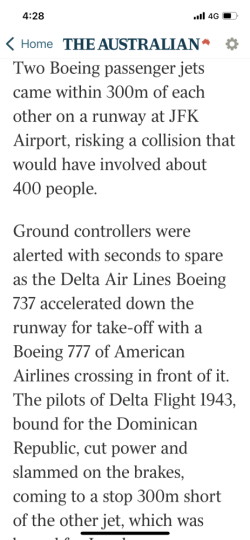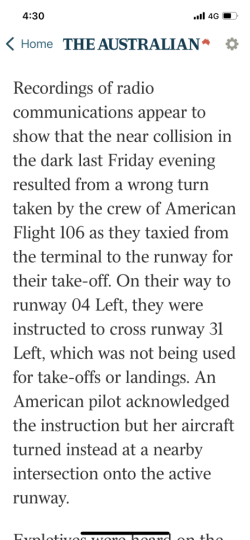You are using an out of date browser. It may not display this or other websites correctly.
You should upgrade or use an alternative browser.
You should upgrade or use an alternative browser.
On ground conflicting paths at JFK
- Thread starter RooFlyer
- Start date
- Status
- Not open for further replies.
Hvr
Enthusiast
- Joined
- Jun 27, 2007
- Posts
- 10,916
- Qantas
- LT Gold
'Delta 1943, cancel take-off!': Agencies investigate averted plane collision at New York airport
Officials are investigating a close call at a New York airport on Friday night between a plane that was crossing a runway and another that was preparing for take-off.
Radio transmission here:
Quickstatus
Enthusiast
- Joined
- Oct 13, 2013
- Posts
- 17,289
Victor from VasAviation about this
See his pinned comment also
The departure runway was 4L
AA 106 was instructed to cross 31L at K but instead crossed 4L at J.
Why will be the subject of some head scratching
See his pinned comment also
The departure runway was 4L
AA 106 was instructed to cross 31L at K but instead crossed 4L at J.
Why will be the subject of some head scratching
Last edited:
justinbrett
Enthusiast
- Joined
- Mar 6, 2006
- Posts
- 11,740
- Qantas
- Platinum 1
- Oneworld
- Emerald
Victor from VasAviation about this
See his pinned comment also
The departure runway was 4L
AA 106 was instructed to cross 31L at K but instead crossed 4L at J.
Why will be the subject of some head scratching
Not correct RT from the TWR controller (unless FAA is different, definitely not ICAO).
Should have been DAL1943 Stop Immediately, DAL1943, Stop Immediately, Aircraft ahead / Runway Occupied etc.
Fortunate that DAL could probably see AAL and understood the instruction. But it risked the pilot assuming it was a procedural lapse (eg incorrect coord from TWR to Departures or something trivial) and deciding to continue. The pilot has the right to continue with the take off roll in either situation.
Quickstatus
Enthusiast
- Joined
- Oct 13, 2013
- Posts
- 17,289
Initially AA106 was instructed to taxi on B then hold short of 4L at K by Ground controller.
This caused the pilots to be facing a runway (4L)
Then instructed by Tower to cross 31L at K,
The AA 106 pilots then crossed the runway in front of them which was 4L instead of turning right at K and crossing 31L
The pilots later queried the Tower - they thought they were cleared to cross. They didnt mention which runway.
Ground told AA106 to hold position when she noticed then encroaching onto 4L. But they didnt comply/didnt hear?
Were the pilots on Ground frequency or tower frequency because the last response from AA106 was to tower
This caused the pilots to be facing a runway (4L)
Then instructed by Tower to cross 31L at K,
The AA 106 pilots then crossed the runway in front of them which was 4L instead of turning right at K and crossing 31L
The pilots later queried the Tower - they thought they were cleared to cross. They didnt mention which runway.
Ground told AA106 to hold position when she noticed then encroaching onto 4L. But they didnt comply/didnt hear?
Were the pilots on Ground frequency or tower frequency because the last response from AA106 was to tower
justinbrett
Enthusiast
- Joined
- Mar 6, 2006
- Posts
- 11,740
- Qantas
- Platinum 1
- Oneworld
- Emerald
Initially AA106 was instructed to taxi on B then hold short of 4L at K by Ground controller.
This caused the pilots to be facing a runway (4L)
Then instructed by Tower to cross 31L at K,
That's not quite correct, the transcript I read had "106 Heavy, Kennedy Ground, Runway 4 Left, Taxi Bravo, hold short of Kilo". There is no mention of J and you can't hold short of 4L at K without crossing 31L first, so that was definitely not the instruction. Stating runway 4L here is not a taxi instruction, it's confirming assigned departure runway.
That's a perfectly valid call - though ICAO phraseology is much clearer (taxi to holding point K RWY 31L // cross runway RWY 31L taxi to holding point K1 RWY 04L).
The crew messed up. You can hear it in the male's voice once told by ATC, he sounds completely deflated and I think he worked out what happened.
jb747
Enthusiast
- Joined
- Mar 9, 2010
- Posts
- 13,521
FAA and ICAO are from different planets. And the controllers at JFK are the just about the worst that I ever experienced. They are also the nastiest. I have no idea of their conditions or anything else, but they are unhelpful and snarky. The exact opposite of Heathrow.Not correct RT from the TWR controller (unless FAA is different, definitely not ICAO).
I'll have to have a look at the entire event.
...Ah yes. Speak at 5 million miles an hour, so that those on the other end might catch part of the call. And if you query it, that's when they'll get stroppy. No need to speak that quickly, it doesn't make things happen any faster. It slows things down, because you'll get many 'say again' calls, especially from the foreign airlines. And then get triply snarky with them, 'cos they just don't listen fast enough.
Last edited:
Elevate your business spending to first-class rewards! Sign up today with code AFF10 and process over $10,000 in business expenses within your first 30 days to unlock 10,000 Bonus PayRewards Points.
Join 30,000+ savvy business owners who:
✅ Pay suppliers who don’t accept Amex
✅ Max out credit card rewards—even on government payments
✅ Earn & transfer PayRewards Points to 10+ airline & hotel partners
Start earning today!
- Pay suppliers who don’t take Amex
- Max out credit card rewards—even on government payments
- Earn & Transfer PayRewards Points to 8+ top airline & hotel partners
Join 30,000+ savvy business owners who:
✅ Pay suppliers who don’t accept Amex
✅ Max out credit card rewards—even on government payments
✅ Earn & transfer PayRewards Points to 10+ airline & hotel partners
Start earning today!
- Pay suppliers who don’t take Amex
- Max out credit card rewards—even on government payments
- Earn & Transfer PayRewards Points to 8+ top airline & hotel partners
AFF Supporters can remove this and all advertisements
Quickstatus
Enthusiast
- Joined
- Oct 13, 2013
- Posts
- 17,289
1000 ft separation
DL instantaneous speed at reject was approx 185kmh. If it did not accelerate past 185kmh it would have taken about 5.8 seconds to traverse 1000ft if it did not reject
As it was accelerating, the time to traverse 1000 ft would be less than that if it did not reject
Anyone know what the acceleration is in m/s2 ?
DL instantaneous speed at reject was approx 185kmh. If it did not accelerate past 185kmh it would have taken about 5.8 seconds to traverse 1000ft if it did not reject
As it was accelerating, the time to traverse 1000 ft would be less than that if it did not reject
Anyone know what the acceleration is in m/s2 ?
jb747
Enthusiast
- Joined
- Mar 9, 2010
- Posts
- 13,521
There's not a fixed answer. It would vary with weight and chosen derate.1000 ft separation
DL instantaneous speed at reject was approx 185kmh. If it did not accelerate past 185kmh it would have taken about 5.8 seconds to traverse 1000ft if it did not reject
As it was accelerating, the time to traverse 1000 ft would be less than that if it did not reject
Anyone know what the acceleration is in m/s2 ?
Assuming a fixed acceleration (it wouldn't be, but too hard to work out otherwise), it would have taken about 32 seconds to reach to point at which they aborted, and it would have taken 36.5 to reach the intersection if they had continued. Conversely, having aborted, you could just about stop from 90 knots in 1,000'. An abort uses a brake setting that is otherwise never touched, but basically maximum braking pressure is applied, and the anti skid system goes into overdrive.
If not for the order to abort, the take off distance would have been in the order of 5,000'. (Again, depending on derate, weight, wind, phase of the moon, etc).
RooFlyer
Veteran Member
- Joined
- Nov 12, 2012
- Posts
- 31,308
- Qantas
- Platinum
- Virgin
- Platinum
- Star Alliance
- Gold
A follow-up from OMaaT, including a link to the NTSB initial report
Absurd: Reckless American 777 Pilots Refuse Recorded NTSB Interviews
Absurd: Reckless American 777 Pilots Refuse Recorded NTSB Interviews
- Status
- Not open for further replies.
Become an AFF member!
Join Australian Frequent Flyer (AFF) for free and unlock insider tips, exclusive deals, and global meetups with 65,000+ frequent flyers.AFF members can also access our Frequent Flyer Training courses, and upgrade to Fast-track your way to expert traveller status and unlock even more exclusive discounts!

AFF forum abbreviations
Wondering about Y, J or any of the other abbreviations used on our forum?Check out our guide to common AFF acronyms & abbreviations.
Currently Active Users
- RB001
- Stone
- mbe1510
- collcars
- paddywide
- marty_gc
- Aeryn
- diamondhands
- Falcs
- Denali
- Noah Count
- AIRwin
- CASETRAV
- Austman
- tassie6
- New to this
- SOPOOR
- Dsaykao
- moa999
- RooFlyer
- dajop
- crosscheck
- Mutilla2
- Doctore1003
- bluecoconut
- SeatBackForward
- hutch
- tim84
- love_the_life
- Up in the clouds
- Archipelago
- Brucetiki
- TheEmu
- Ko0l
- mouseman99
- FlyingKangaroo
- jkbaus
- kpc
- Happy Dude
- themaiz
- Rich
- swellington
- Dominic69074
- MEL_Traveller
- Desperado2
- Harrison_133
- Rebus
- Viridis
- _TheTraveller_
- NickC
Total: 1,587 (members: 78, guests: 1,509)















